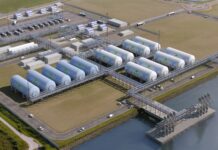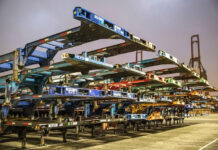
The Port of Long Beach (POLB) will start collecting its Clean Truck Fund Rate on 1 April 2022 to support the goal of a zero-emissions truck fleet by 2035, as approved by the Long Beach Board of Harbor Commissioners.
Currently, trucks constitute the largest source of greenhouse gas (GHG) emissions and the second-highest source of nitrogen oxides at the Californian port.
In an effort to confront this issue, San Pedro Bay Ports had set a rate for nonexempt trucks of US$10 per TEU earlier in March 2020, encouraging the trucking industry to invest in cleaner vehicles and accelerate the reach of the zero-emissions goal.
Hence, zero-emissions trucks are exempt from the rate, and the US second-busiest port has approved an expiring exemption for the cleanest natural gas-powered trucks, as a transitional step to a future when zero-emissions cargo trucks will be widely available.
The Board approved an initial funding prioritisation for both low-nitrogen oxides and zero-emissions trucks, with at least 10% of the funds to be provided to zero-emissions trucks.
According to a statement, the Clean Truck Fund rate in San Pedro Bay is expected to generate US$90 million in the first year or US$45 million per port.
“As cargo volume continues to break records, it’s critical that we transition to a zero-emissions fleet,” said Long Beach Mayor Robert Garcia. “Our Clean Truck Fund is a bold step forward towards cleaner air and addressing our climate crisis.”
“Speeding progress toward the zero-emissions trucks goal is important, in spite of the business uncertainties created by the pandemic,” sted Harbor Commission President Steven Neal. “This rate allows us to balance aggressively pursuing zero-emissions goals with economic vitality and competitiveness,” he pointed out.
The Clean Air Action Plan (CAAP) which was originally approved in 2006, has established a goal of zero-emissions trucks by 2035 and was updated in 2017 with a strategy to accelerate progress toward a zero-emissions future while protecting and strengthening the ports’ competitive position in the global economy.
The document calls for the ports to reduce GHGs to 40% below 1990 levels by 2030 and 80% below 1990 levels by 2050.
Since 2005, the port-related air pollution emissions in San Pedro Bay have dropped 89% for diesel particulate matter, 63% for nitrogen oxides and 97% for sulfur oxides, according to the POLB, while targets for reducing GHGs from port-related sources were introduced as part of the 2017 CAAP Update.
“Reaching zero emissions will take intense collaboration among our trucking and other goods movement partners. The good news is that we’ve already achieved a great deal with our Clean Truck Program and this is one more step toward a cleaner future,” commented Port of Long Beach Executive Director, Mario Cordero.





